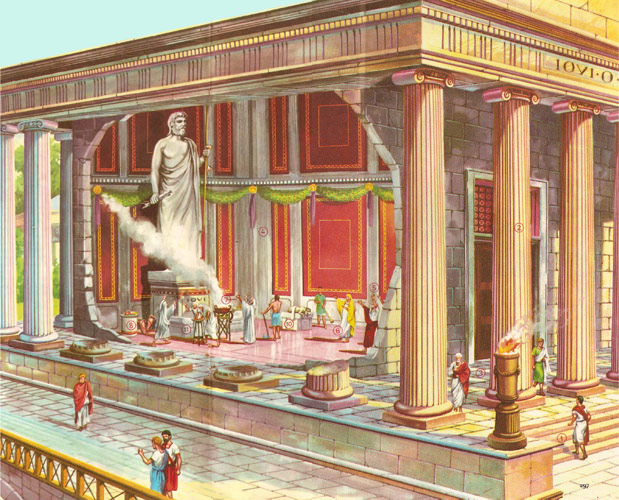Roman temple

Diagram of the main features of a Roman temple, showing the functions performed in each part. Note: The various actions shown would not in fact have all taken place simultaneously.
In the early days of Roman history, there were no buildings devoted to the worship of the gods: a "temple" consisted merely of a quadrangular space marked out on the ground by priests. Later, however, stone temples were built specially for religious ceremonies. As time passed, these gradually became more and more rich and magnificent.
1. A Roman temple usually stood on a high platform (podium), approached at one end only by a long and steep flight of steps (not visible in this picture).
2. The colonnade, or row of columns, was characteristic of Roman temples. Some had columns only along the front, an others at both ends; others again had a row of columns the whole way round.
3. The deep porchway between the colonnade and the doorway was called the pronaos.
4. This room, called the cella (in Greek naos), was the temple proper, and was quite small. It contained the statue of the god (often of enormous size), the shrine, and other altars.
5. and 6. These are worshippers in the act of praying. A Roman stood to pray, with his arms held out, and his head covered with the edge of his toga, so that he should not see anything of ill omen.
7. Incense was offered to the gods by being burnt, as here, in a brazier.
8. In a bloodless sacrifice, various foods such as fruit, cakes, and grain were first consecrated by prayer to the god, then laid upon the altar or burnt.
9. These are large jugs (amphorae) containing offerings of wine, milk, and honey.
10. An animal is about to be sacrificed on the altar. The ritual for this was elaborate, and the slightest mistake meant starting all over again. First the animal was led to the altar crowned with a garland of flowers and adorned with a white band. A crier ordered silence, and warned sinners to depart. While the fires were being lit the priest sprinkled the victim with wine, and with a special mixture of meal and salt called mola salsa. Pipers played, to drown any ill-omened sound, and the priest recited the prayer under his breath. The victimarius (assistant at the sacrifice) killed the victim with a stroke of the axe aimed at the head; the flowing blood was collected and sprinkled over the alter.
11. The haruspices (soothsayers) then examined the victim's entrails, and especially the liver, with great care for clues to the will of the gods, which they believed could be found in them. If the entrails were of good omen, and such as would satisfy the god, then they too were put on the altar, splashed with wine, and burnt. The remaining parts of the animal's body were usually eaten by the people who had offered it; for a sacrifice was often considered as a meal at which the god was the guest of honor.
